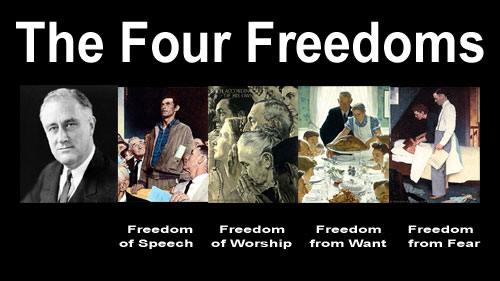|

The
State of the Union address that President
Franklin Delano Roosevelt delivered before
the US Congress on January 6, 1941 is
famously remembered as the Four Freedoms
speech. In this speech, President Roosevelt
outlined four basic freedoms that everyone
in the world should enjoy: freedom of
speech; freedom of worship; freedom from
want; and freedom from fear. A century
and a half before, the US Bill of Rights
had outlined basic human rights guaranteed
to all US citizens. The first two of Roosevelt's
'four freedoms' were covered by the First
Amendment, but in his proposal, President
Roosevelt significantly presented the
idea that other basic rights were equally
important, and should be shared not just
by Americans, but by the citizens of every
nation.
'Freedom
from want' addressed the idea that every
person had a basic human right to economic
security. Access to food, water, shelter
and health care were all basic human rights.
This concept would later become known
as 'human security' in social science
and economic development theory and policy.
'Freedom
from fear' suggested that peace was also
a human right. Society has an obligation
to protect individuals from violence in
their communities, and the global community
has an obligation to protect individual
nations from violent aggression by other
nations. This issue was particularly relevant
as at the time Europe was embroiled in
the devastating Second World War after
Germany and Japan's aggressive invasions
of neighboring nations. It would be 11
months before the United States would
enter World War II, and Roosevelt's intention
in including this fourth fundamental freedom
was to inspire a national moral conviction
to help our allies. It was also to promote
the idea of creating institutions that
would help to maintain a peaceful global
community when that current global crisis
was resolved. The formation of the United
Nations at the end of the war would be
a manifestation of this idealistic vision.
Although
many in the world at the time were living
without any of these freedoms because
of World War II, President Roosevelt saw
the achievement of a world where all shared
these four freedoms as a reasonable goal.
"That is no vision of a distant millennium.
It is a definite basis for a kind of world
attainable in our own time and generation."
First
Lady Eleanor Roosevelt's passion for the
ideals her husband expressed in The Four
Freedoms speech was clearly reflected
in the drafting of the Universal Declaration
of Human Rights she spearheaded; the four
freedoms are included in the preamble,
and the Declaration itself expanded and
more clearly defined the basic rights
to which all people are entitled.
President
Roosevelt's speech inspired many cultural
manifestations of the ideals he presented.
Iconic illustrator Norman Rockwell's Four
Freedoms paintings were seen by millions
in The Saturday Evening Post in 1943 and
raised 130 million dollars in war bond
sales when the US Treasury Department
toured them around the nation. Murals,
monuments and parks were created, such
as Michael Lenson's mural at the Fourteenth
Street School in Newark, New Jersey, and
New York City's Four Freedoms Monument
in Madison Square Garden and Four Freedoms
Park on Roosevelt Island. The Four Freedoms
Award is presented each year to individuals
who have dedicated their lives to these
ideals.
|